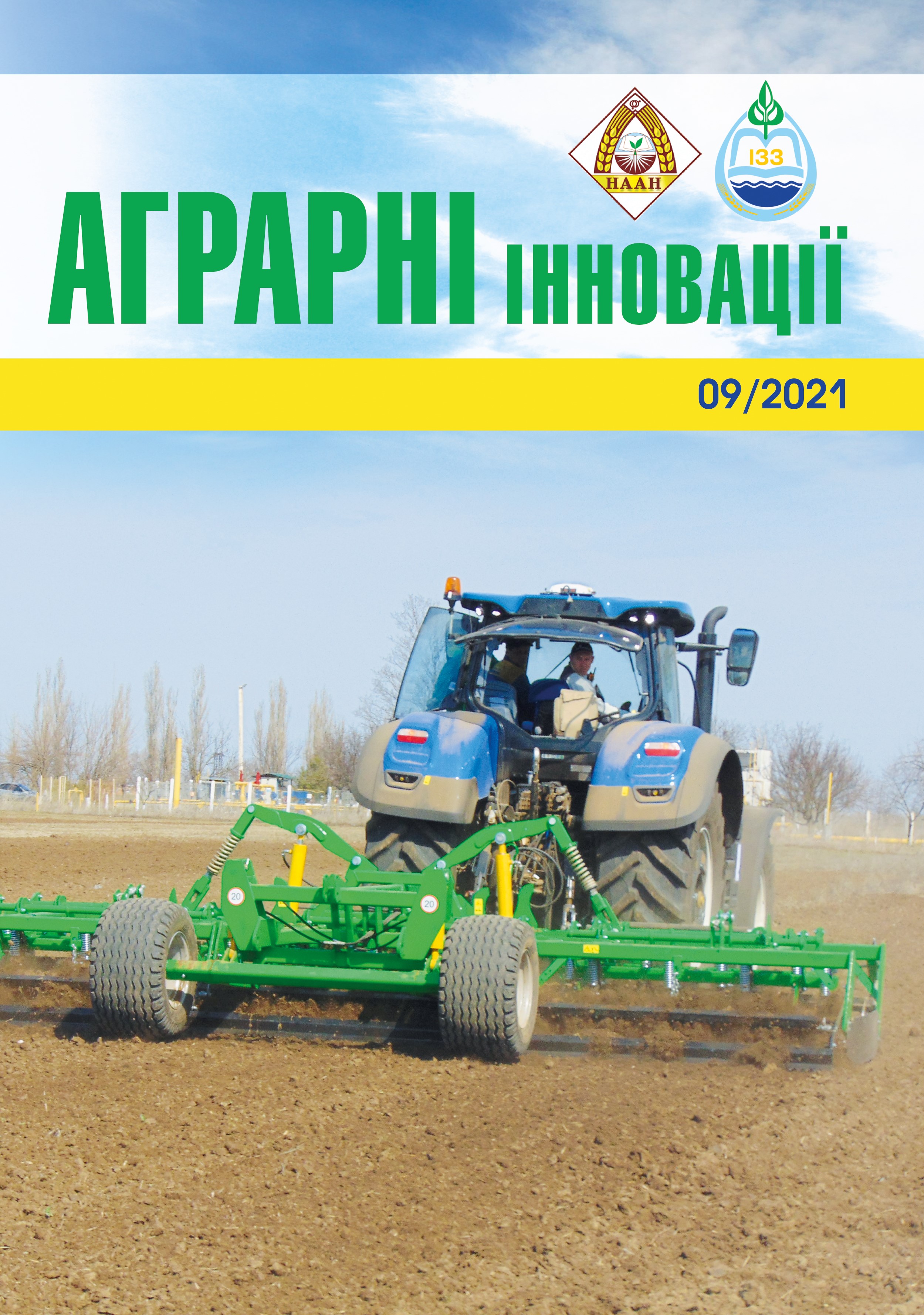Influence of abiotic growing conditions on the development of Propylea Quatuordecimpunctata as an agent of biological plant protection
Abstract
Purpose. The aim of the study was to determinethe influence of abiotic factors on the developmentof Propylea quatuordecimpunctata in the technocenosisMethods. During development, representativesof the species P. quatuordecimpunctata were keptat different temperatures. Terms of development of eggs,larvae, pupae, and their survival were determined.The optimal substrate and optimal density for growingcoccinellid in the juvenile stage were also determined.Results. The highest hatching of P. Quatuordecimpunctatalarvae from eggs took place at a temperatureof 20 оС and was 72%. The lowest regeneration of larvaewas observed at a temperature of 30 оС. The highestsurvival in the juvenile stage was observed in the variantwhere the temperature was maintained at 25 °C. 68.2%of larvae were hatched. The least insects reachedthe stage of pupae at a temperature of 15 оС – 32.6%. Mostadults were born from pupae that grew at a temperatureof 25 оС – 80%. The best development of larvae and pupae of P. quatuordecimpunctata was observed in the variantwhere cut straw was used as a filler in containers in whichinsects were kept. The hatching of adults compared tothe initial number of larvae was 58.3%. The lowest resultof 44.6% was observed when using foam balls. At a densityof 10 and 20 larvae of P. quatuordecimpunctata, survivaldid not differ significantly in capacity. Even with 20 larvae,their mortality is approaching the minimum.Conclusions. For incubation of P. quatuordecimpunctataeggs, a temperature of 20 °C is best, while a temperatureof 25 °C is optimal for the development of larvae and pupae.Among the proposed options, the best development of larvaeand pupae of P. Quatuordecimpunctata is observed whenused as a filler in containers for keeping insects cut straw. Asa result of studies comparing the number of revived adultsand the percentage of their rebirth in relation to the initialnumber of larvae, it was determined that the optimal initialnumber of insects in the juvenile stage is 20–30 individualswith a volume of 0.22 liters.
References
2. Бокина И.Г. Эффективность энтомофагов в снижении численности злаковых тлей в Западной Сибири.Аграрная наука – сельскохозяйственному производству Казахстана, Сибири и Монголии: Тр. XII Международной науч.-практич. конф. (Шымкент, 16–17 апреля 2009 г.). Алматы: Изд. «Бастау». Т. 1. С. 314–315
3. Семьянов В.П. Разведения, длительное хранение и применение тропических видов кокцинеллид для борьбы с тлями в теплицах. М.: Товарищество научных изданий КМК, 2006. 29 с.
4. Тамарина Н.А. Основы технической энтомологии М. Изд-во МГУ. 1990. 204 с.
5. Попов Н.А., Белоусов Ю.В. Методические указания по разведению и применению хищной галлицы афидимизы. Кишинев: Типография ГВЦ Госкомстата МССР. 1989. 34 с.
6. Молчанова О.Д., Баркар В.П., Ольшевська Л.В. Розведення кокцинелід в штучних умовах. Тези доповідей IX з’їзду Українського ентомологічного товариства. (м. Харків, 20–23 серпня 2018 р.). Харків, 2018. С. 80–81.
7. Молчанова О.Д, Баркар В.П. Створення лабораторних культур кокцинелід. Матеріали міжнародної науково-практичної конференції з нагоди 100-річчя Національної академії аграрних наук України. Біологічний метод захисту рослин: досягнення і перспективи. Одеса 2018. С. 241–245.
8. Papanikolaou N.E., Milonas P.G., Kontodimas D.C., Demiris N., Matsinos Y.G. Life table analysis of Propylea quatuordecimpunctata (Coleoptera: Coccinellidae) at constant temperatures.Annals of the entomological society of America. 2014. Vol. 107, No. 1. PP. 158–162.
9. Papanikolaou N.E., Milonas P.G., Kontodimas D.C., Demiris N., Matsinos Y.G. Temperature-Dependent Development, Survival, Longevity, and Fecundityof Propylea quatuordecimpunctata (Coleoptera: Coccinellidae). Annals of the Entomological Society of America. 2013.106(2). P. 228–234.
10. Тюмасева З.И. Кокцинеллиды Урала и сопредельных территорий. Монография Челябинск. Изд-во Челяб. гос. пед. ун-та 2013. 248 с.
11. Hämäläinen M., Markkula M. Cool storage of Coccinella septempunctata and Adalia bipunctata (Col., Coccinellidae) eggs for use in the biological control in greenhouses. Annales agriculturae fenniae. Helsinki. 1977. V. 16. P. 132–136.
12. Miller J. C. A Comparison of Techniques for Laboratory Propagation of South American Ladybeetle, Eriopis connexa (Coleoptera: Coccinellidae). Biological control. 1995. 5. P. 462–465.
13. Katsarou I., Margaritopoulos J. T., Tsitsipis J. A., Perdikis D.Ch., Zarpas K. D. Effect of temperature on development, growth and feeding of Coccinella septempunctata and Hippodamia convergens reared on the tobacco aphid, Myzus persicae nicotianae. BioControl. 2005. 50. P. 565–588.
14. Белякова Н.А. Контроль качества энтомофагов на биотехнологических производствах. Международная научно-практическая конференция «Современные технологии и средства защиты растений – платформа для инновационного освоения в АПК России» 8–12 октября 2018 г. Сборник материалов. Санкт-Петербург – Пушкин 2018. С. 26–27.






